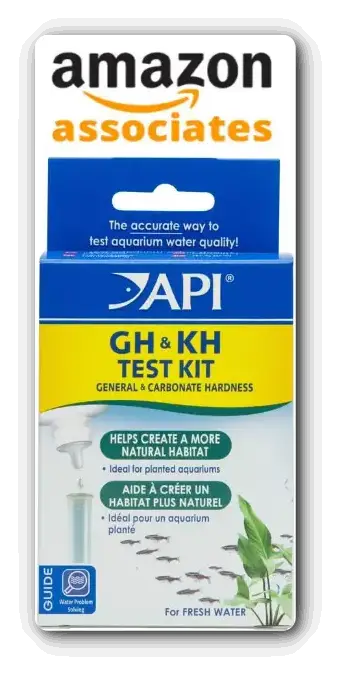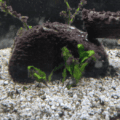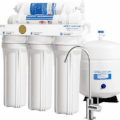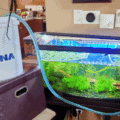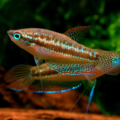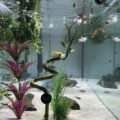Ensuring an optimal environment for our pet fish involves considering every aspect of their habitat, including the water they swim in. Many aquarists wonder about the suitability of natural spring water for their tanks, drawn in by its mineral-rich composition and absence of artificial additives. However, the decision isn’t as straightforward as it seems. In this in-depth exploration, we delve into the intricacies of using spring water in aquariums, weighing its benefits and drawbacks.

In this sense, the chemical composition of spring water makes it seem like one of the best water sources for a fish tank.
This is unsurprising since it also lacks any artificial disinfectants that may harm fish.
But is spring water actually safe enough for our pets?
Importance of Using water for fish tank
Maintaining optimum water conditions is extremely necessary for the health and betterment of your aquarium pets. Aquarium water quality influences the overall well-being of the species, and choosing the right water source significantly impacts attaining this equilibrium.
Importance of water quality:, Water is not only essential for the hydration of fish but also acts as a medium for the excretion of waste, respiration, and communication, which also take place via water. Poor water quality proves detrimental for the fish as this causes health problems and stress. Water parameters like ammonia, nitrate, temperature, and pH should be maintained at appropriate levels for the better growth of fish health.
It is a well-accepted misconception that spring water is good for fish as compared to other water; it may have some qualities, but it is necessary to check its composition due to its varied content such as mineral content, pH, and other parameters based on location, season, and geographical characteristics.
Unlike spring water, treated tap water designed for aquarium use can provide more consistent water parameters like pH and hardness because it is subjected to a rigorous filtration process to remove impurities. By utilizing such water, the water quality can be maintained better.
Can you really use spring water for the fish tank?
Due to spring water’s perceived purity and originality, its use has become the best choice among aquarists. Notwithstanding, checking its parameters, benefits, disadvantages, testing, and treatment methods are important to consider before using in a tank.
Benefits of Spring Water in Aquariums
Springwater aquariums are generally thought to have no contaminants or particulate matter typically associated with tap water, such as chlorine and chloramines.
Many spring waters have perfect pH and mineral levels appropriate for fish, especially those surviving in hard water.
Potential Challenges:
Variation:
Spring water composition can vary significantly depending on its location, season, and geography, resulting in inconsistency in parameters.
Contamination:
Despite its natural origin, it may contain many contaminants and pollutants, depending on its location and origin.
Testing Requirements:
Thoroughly test and check the parameters such as pH, hardness, mineral contents, and contaminants using specialized kits before using in an aquarium.
Treatment:
If the spring water contains pollutant and contaminants or its parameters are unsuitable, it must be treated first. Water conditioners can be used to neutralize chlorine or chloramine and regulate it, and filtration, filtration can also be done to eliminate impurities.
Supplements and additives may be necessary to adjust water hardness in the tank to make the water quality desirable for hardwater fish species.
Alternatives:
Tap Water:
Treated tap water or purified water can serve as an alternative to spring water. Water conditioners can remove chlorine or chloramine in tap water and detoxify heavy metals.
Reverse Osmosis (RO) Water:
The process of reverse osmosis can be used to eliminate impurities and pollutants and provide better quality water, enabling you to regulate parameters according to your fish requirements.
Understanding Spring Water for Aquariums
Spring water is mineral-rich and acts as a natural alternative to tap water. Minerals in spring water include calcium, magnesium, and other trace elements, which confer numerous advantages upon aquarium species. When selecting spring water for an aquarium, consider the variability in, water parameters, general hardness, carbonate hardness, and mineral content.
Minerals in spring water:
Spring water comes up from the ground and is filtered out by rock layers; during this process, numerous minerals become part of the water.
Two essential minerals in spring water are calcium and magnesium, which cause the hardness of water and are vital nutrients the growth of aquatic life.
Nonavailability of tap water Additives:
Spring water is devoid of additives like chlorine and chloramine, which are also disinfectants. These additives are generally found in tap water.
Due to the chlorine-free nature of the spring water, there is no need for water conditioners to neutralize these additives, thus mitigating the stress on the fish.
Variability in Source, Hardness, and Mineral Ratios:
Spring water varies in source; different springs have characteristic mineral content and hardness, causing variation in the water parameters.
Different springs have different hardness, generally measured as General hardness (GH) and Carbonate Hardness (KH). This can affect the pH level of the aquarium.
The calcium to magnesium ratio (Ca: Mg) in spring water also varies, changing the water chemistry and affecting the health of aquarium inhabitants.
Water Testing:
Conducting water tests using specialized test kits before transferring the water into the aquarium is important to avoid stressing your fish.
Testing for parameters such as GH, KH, pH, and mineral content enables aquarists to evaluate the appropriateness of Springwater minerals for their specific fish species and regulate them accordingly.
Can you use natural spring water for your fish tank?
Natural spring water can be a hit or miss if you decide to use it for your aquarium.
Whether this type of water is good or bad for your pet fish has to do with its origins:
Spring water is any water that comes from an underground source.
Along the way to the top, this groundwater dissolves different minerals from the surrounding rocks in itself, most prominently Magnesium and Calcium.
This makes it mineral-rich, making it hard as it reaches the surface.
Now, the question really becomes whether hard water can be used in an aquarium. Plenty of aquarium pet fish thrive in hard water; for some it’s a crucial part of their natural environment.
Some freshwater fish that do well in hard water aquariums are:
- Livebearers such as guppies, the platy, swordtail fish, and Mollies
- Some species of killifish like the Golden Wonder killifish
- Some species of rainbowfish
- African cichlids and some species of South American Cichlids
- Some Barb species
Sounds promising, right?
Before you conclude, consider the following:
The metric used to show how hard water is is called General Hardness (GH).
GH measures the total sum of all dissolved minerals in the water.
However, no one really tells you WHAT those minerals are.
And this teeny-tiny detail is relevant if you’re to put live fish in that water.
For any naturally hard water, the largest portion of minerals responsible for its hardness is Magnesium and Calcium. The volume of both minerals and GH can vary significantly across the springs from which the water was collected.
Unlike land animals fish draw the minerals needed for their bodily functions from the water they live in and not their food. Research suggests that a skewed Calcium to Magnesium ratio of aquarium water can affect how freshwater fish develop in it.
My research shows that freshwater aquariums’ ideal Ca:Mg ratio should be between 3:1 and 4:1.
However, this is more of a reference point than anything and is not something you should obsess over.
Issues may arise only when your spring water Ca:Mg ratio is greatly skewed (like 20:1).
So from this, we can conclude the following about using spring water in an aquarium:
First, you should test how hard your spring water is and then research what water hardness the fish in your aquarium prefer living in. If the two align nicely, you can use the water. Ideally, the water should contain a balanced Calcium to Magnesium ratio of 3:1 and 4:1.
Getting a GH test kit is the simplest way to determine the hardness of your water source. There are also water test kits specifically designed to detect Magnesium and Calcium.
Finding and Testing Spring Water
Locating a potential natural spring water source for use in your aquarium requires careful consideration and thorough research.
Choosing spring water for your aquarium requires thorough consideration and research of the water. Principles and guidelines for testing spring water have been listed here.
Finding Natural Spring Water Sources:
Research: Start the search for natural spring water in your locality. Local geological maps, online databases, or government resources might provide information on local springs.
Field Exploration:
Hillsides, valleys, or areas with visible water sources should be explored for potential springs. Bubbling up of water from the ground is a sign of spring.
Assessing Water Quality:
Springwater sources should be evaluated for clarity and signs of contaminants such as pollutants or debris.
Sample collection:
Take out direct samples from the spring using sterile containers to avoid potential contamination.
Aquarium Water Testing:
General Hardness (GH):
General hardness measures calcium and magnesium content in water, for which specialized test kits are available.
Carbonate Hardness (KH):
KH measures the buffering quality of water, showing its resistance to changes in pH. Keeping stable KH levels is crucial for preventing pH fluctuations in the aquarium.
Nitrates:
Nitrate water levels should also be measured using specialized water test kits. Nitrate levels can badly impact the health of aquatic life, which is an indication of the contamination of organic matter or agricultural waste.
Interpreting Test Results:
Optimal GH and KH levels depend on the requirement of your fish species but generally should remain within the range of 4-8 dGH for GH and 3-6 dKH for KH.
Nitrates should ideally be kept below 20-40 ppm (parts per million) in freshwater aquariums to prevent algae growth and maintain water quality.
Treatment and Monitoring:
If test results indicate unsuitable water parameters, consider treatment options such as dilution with distilled water or using water conditioners to adjust GH, KH, and pH levels.
Treating Spring Water for Aquarium Use
To improve the health and wellness of fish, it is recommended that spring water be treated. Though spring water is thought safe and devoid of tap water additives and contaminants such as chlorine, it is best to subject the water to de-chlorination; it is a proactive measure to neutralize and eliminate any chlorine or chloramine residue that might be part of the spring water.
De-chlorination:
Spring water, despite its natural origin, may contain a small amount of chlorine or chloramine, mainly, if the springwater has been treated for storage and bottling.
For de-chlorination, good-quality water conditioners have been purposefully designed for aquarium use. Seachem Prime, an efficient product, has been widely used to neutralize chlorine, chloramine and detoxify heavy metals.
Sticking to the prescribed and recommended dosage instructions is crucial for better results.
Demineralization:
Spring water from different sources has different mineral compositions, and aquarium fish species require specific mineral levels for maintenance and growth.
Water parameters like general hardness (GH) and carbonate Hardness (CH) must also be checked after de-chlorination using specialized test kits.
If the test demonstrates an inappropriate mineral level, remineralization is done by utilizing mineral supplements that are commercially prepared for such purpose. To attain the proper level of GH and KH, strictly follow the manufacturer’s advice.
Aquarium water filtration:
Although spring water is free from visible contaminants, impurities, and particulate matter, filtration should also be conducted to clean spring water from sedimentary particles or invisible microbes.
Mechanical filters with excellent filter media to eliminate and trap debris is a good option.
To maintain and improve the efficiency and effectiveness of the filtration system, regular and proper maintenance, such as cleaning and replacing overused vital components.
Is Bottled Spring Water Safe for Your Pet Fish?
Conveniently having a natural spring water source nearby is not something everyone can boast about.
Store-bought bottled water goes through treatments that may affect its usability in fish tanks:
There’s a slight chance that bottled spring water is disinfected with chlorine.
To be safe, use a water conditioner to dechlorinate the water before using it in your aquarium.
Most bottled water manufacturers typically use ozonation or chlorination to disinfect their product from potentially harmful bacteria.
When the water is treated with chlorine, there’s typically a follow-up procedure to remove any chemical leftovers.
However, this practice is not really guaranteed, and we as fish keepers, should be “pessimistically careful” about what we put in our precious aquariums.
As mentioned earlier, Seachem Prime is one of the best water conditioners to use in your aquarium.
Closely follow the instructions and your pet fish should be safe. There are also more natural ways to dechlorinate water at home, but most are impractical for fish keeping because they take too much time.
Benefits of Bottled Spring Water:
Bottled spring water is frequently sourced from natural sources and is free from the additives commonly found in tap water, such as chlorine, fluoride, or heavy metals.
Its consistent mineral content and pH level can provide a stable environment for aquarium inhabitants, particularly for species that prefer specific water parameters.
Considerations:
Despite its benefits, bottled spring water can be more costly and less environmentally friendly than treating tap water with a reliable water conditioner.
How does spring water compare to other aquarium water sources?
- Tap Water
As many would confirm, tap water is a decent water source that you can use to start an aquarium.
Unlike spring water, you can be sure that water from your sink contains either chlorine or chloramine. If your only alternative is to use tap water for your fish tank, make sure to treat it with a water conditioner beforehand.
When comparing tap and spring water, I believe that spring water is a better option for someone looking to fill their tank.
Drinking water in older city systems also has too many artificially added phosphates, which can induce algae issues in an aquarium.
On top of that, water quality varies from region to region. It could be that your tap water turns out perfect for your fish but your neighbor’s tap brings a disaster for theirs. Learn more on tap water and its effect on your tank.
Distilled water is not a good option for setting up a fish tank, which makes spring water the superior choice.
Distilled water goes through a pretty rigorous filtration process that eliminates bacteria and metals, but it also removes helpful minerals such as calcium, and magnesium.
Spring water may be cleaned with chlorine for killing harmful organisms, but it still retains many of helpful minerals after the process.
So, if you had to choose between spring water and distilled water, I would highly recommend spring water as the better option.

by Codedinc
This doesn’t mean that you can’t ever use distilled water in your aquarium journey, but it shouldn’t be the first choice.
Due to how thoroughly the water is purified, you would have to add a lot of minerals that were stripped during the purification.
If your tank water has evaporated somewhat, distilled water is a good option to top off the losses.
That’s because evaporation does not mess with the mineral contents in the aquarium. To learn more about distilled water and why it isn’t the best choice for your fish, click here.
Reverse osmosis water is purified by filtering any type of water through what’s known as a semipermeable membrane. Chemicals, metals, and other contaminants get filtered by the membrane.
In terms of quality, RO water is similar to distilled water.
This makes spring water better as it is an almost ready-made solution for an aquarium, unlike RO water.
The main difference between spring water and deionized water is mineral/nutrient retention.
None of the minerals that naturally come with spring water are removed in its disinfection.
On the other hand, Deionization strips the water of its mineral content and even removes Nitrate.
Additionally, Deionized water does not filter bacteria. Some bacteria will be helpful to your aquarium’s ecosystem, but others can prove to be quite the problem if left to dwell with your fish.
All in all, spring water is a safer bet for aquariums than Deionized water.
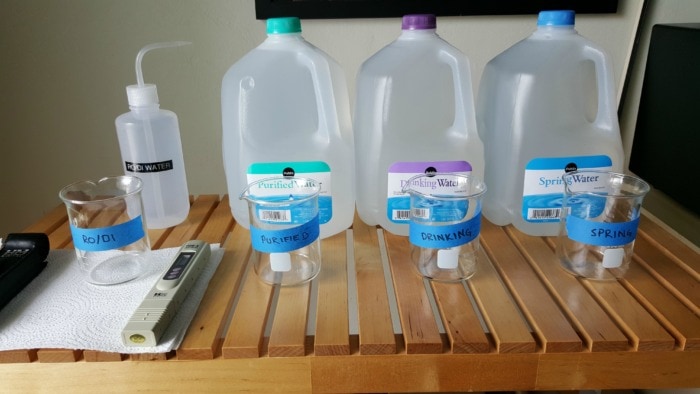
by chemchris
When comparing spring water and purified drinking water to one another, spring water comes out on top, here’s why:
Purified water lives up to its name of being pure, meaning that it lacks a lot of vital minerals and nutrients needed to sustain your aquarium fish.
Although spring water may contain chlorine which is toxic to fish, a dedicated water conditioner can easily remove the chemical.
Purified water is basically any water that has gone through some form of purification.
The purification process could be distillation, reverse osmosis, or deionization.
Adding purified water to your aquarium without any intervention will ultimately kill your fish due to its lack of essential nutrients and minerals they need.
If you plan on using purified water to fill your aquarium, take the necessary steps by putting back in minerals and salt to balance them to appropriate levels.
Author’s note: Water purified with a sand filter cannot remove harmful chemicals, so keep this in mind when picking what brand you want to use.
After researching mineral water versus spring water, I discovered that they are fairly equal in terms of their use in fish tanks with the favor leaning towards spring water.
They also both contain vital minerals and nutrients that fish need to survive.
Like spring water, mineral water is ideal for aquariums with fish that need higher GH. Mineral water, like most bottled water, is treated to be fit for human consumption, which typically means it may contain some chlorine.
Mineral water may be collected from under the ground, similar to well water.
However, some companies just purify water and then artificially re-mineralize it.
What type of water would be best for aquarium fish?
Choosing the right type of water for your aquarium is crucial for the health and well-being of your fish, and it largely depends on matching the water parameters to the specific needs of your fish species. One of the most critical factors to consider is whether your fish prefers hard water or soft water conditions.
Selecting suitable water for your aquarium is extremely necessary for the wellness and health of fish, and it depends upon matching the water quality to the requirements of the fish. One of the important considerations to know is your fish preference.
Importance of Matching Water to Specific Fish Needs
Different fish prefer to survive in specific water environments, including the hardness or softness of water.
Offering water with suitable parameters for your fish reduces stress and other health problems.
Hard Water vs. Soft Water Suitability:
Hard Water Fish:
Certain fish species, such as African cichlids, livebearers like mollies and guppies, and certain species of tetras, have a disposition to live in hard water. Hard water is composed of higher levels of dissolved minerals, especially calcium and magnesium.
Soft Water Fish:
Conversely, other species like discus, certain tetras like cardinal tetras, and many Amazonian species have a preference for soft water. Soft water has a lower mineral content and is more acidic.
Considerations for Beginner Aquariums:
Aquarists just starting in the aquarium industry are advised to start with fish that are widely adaptable.
For beginner aquarists, fish speciesspecies of fish like guppies, platies, and neon tetras are consideredthought to be good options.
Testing and Adjusting Water Parameters:
Regularly testing the water parameters such as pH, and hardness by using specialized test kits that provide precise and accurate measurements, and regulate the quality is a must, irrespective of preferred water.
Acclimation Process:
Acclimatization is necessary for the fish being introduced into the aquarium for the first time due to the difference in contrast from the fish’s previous environment.
Gradually regulating water parameters and temperature over a few hours aids in minimizing the stress on the fish.

When looking at all the options available, spring and mineral water shine as the best ones to use in an aquarium.
Tap water is also feasible and commonly used as it is the most accessible option.
You will have to treat all of them with a fish water conditioner, but you won’t have to worry about essential minerals being stripped away.
This is all based on the premise that you would keep fish that do well in hard water.
Keeping soft-water fish is not recommended for beginners. This is because these species are more sensitive, and it’s a difficult task to keep soft water stable.
Author’s note: One of the most common fish sold to beginner aquarists is the Betta fish (Betta splendens). These fish are commercially bred in hard water conditions to make them more adapted to the tap water most beginners use in their new tank. However, Bettas naturally originate from soft waters with high acidity and tend to do better, and live longer in aquariums with such conditions.
My Closing Thoughts
It might feel overwhelming trying to figure out what type of water best fits the aquarium you want to create.
When things seem complicated, try to keep them simple. In my opinion, it’s best to stick with what works.
Spring water is an excellent choice for multiple reasons, but if that doesn’t work for you, tap water is another viable solution.
To practice successful and responsible fishkeeping, assessing and testing water is inevitable. Understanding the qualities of both spring and tap water is crucial in choosing a suitable one.
For the measurement of water parameters like pH, hardness, and mineral content, aquarium water testing kits are your best bet.
Both spring and treated tap water offer specific options for the aquarists, it is up to the aquarists to select the better one. Spring water contains high mineral content but lacks additives of treated tap water, providing purity. However, different springs have different mineral compositions.
On the other hand, treated tap water containing additives and eliminated contaminants can be convenient and easily accessible. Water conditioners neutralize chlorine, creating a safe environment.
Conduct your research to determine what works best for you and your new friends.

